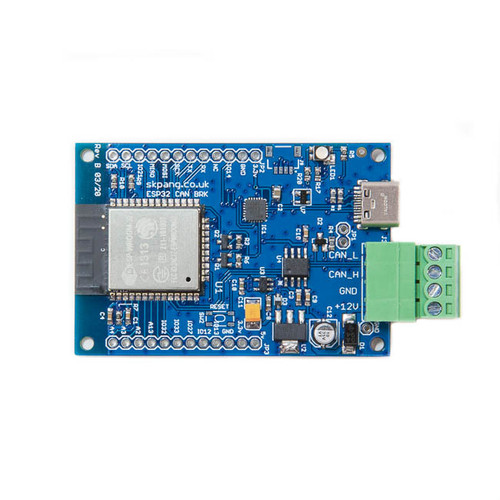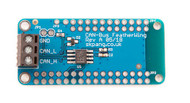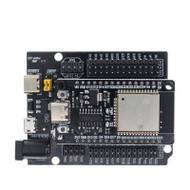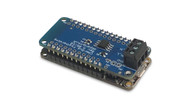Product Description
Free Shipping Within the United States!
The ESP32 CAN-Bus Module brings together wireless and wired communication capabilities on a compact and powerful development board. At its core is the ESP32-WROOM-32 module, featuring a dual-core Xtensa LX6 processor running at up to 240 MHz, supported by 520 KB of SRAM and 4 MB of flash memory. This enables robust performance for a wide range of embedded applications.
Wireless connectivity includes both Wi-Fi (802.11 b/g/n) and Bluetooth, with support for both Bluetooth Classic and Bluetooth Low Energy (BLE), making the module ideal for IoT applications, remote monitoring, and smart device integration. On the wired side, the board includes a native CAN interface using the ESP32’s built-in TWAI (Two-Wire Automotive Interface) controller, paired with a 3.3 V CAN transceiver for seamless communication over the CAN bus.
The module supports classical CAN 2.0B communication at speeds up to 1 Mb/s and handles both standard (11-bit) and extended (29-bit) identifiers. It also provides features like programmable bit timing, acceptance filtering, and interrupt-driven operation, making it suitable for use in automotive diagnostics, industrial automation, and intelligent transport systems.
Power is supplied via a Micro USB connector or external headers, and the board includes a voltage regulator to manage 5 V to 3.3 V conversion. It offers multiple I/O pins accessible through headers for expansion and integration with other devices. The onboard USB-UART bridge makes programming and debugging straightforward using standard development tools like the Arduino IDE or Espressif’s ESP-IDF.
This module is a versatile and efficient solution for developers looking to combine wireless communication with CAN bus networking in a single, compact platform. Whether you're designing connected vehicles, sensor networks, or smart industrial systems, it delivers the performance and flexibility required for modern embedded projects.
About the ESP32 Microcontroller
The ESP32 series by Espressif Systems is a low-cost, low-power system-on-chip (SoC) solution with integrated Wi-Fi and dual-mode Bluetooth. The WROOM-32 module on this board is powered by a Tensilica Xtensa LX6 processor, available in dual-core configuration and clocked up to 240 MHz, capable of delivering 600 DMIPS of processing power.
Additional internal features include:
-
520 KB of SRAM (with 448 KB available to user applications)
-
4 MB of onboard Flash memory (integrated into the WROOM-32 module)
-
On-chip RF components including:
-
Antenna switch
-
Power amplifier
-
Low-noise receive amplifier
-
RF balun and filters
-
-
Integrated power management modules for efficient energy consumption
Integrated CAN Bus Controller and Transceiver
One of the most compelling features of this board is the integrated CAN Bus port, which utilizes the ESP32's built-in SJA1000-compatible CAN controller (known as TWAI – “Two-Wire Automotive Interface”) and a high-speed 3.3V CAN Bus transceiver.
Key CAN Controller Features:
-
Supports Classical CAN 2.0B at speeds up to 1 Mbps
-
11-bit (standard) and 29-bit (extended) CAN identifiers
-
Fully programmable bit timing and acceptance filtering
-
Error handling and message prioritization compliant with the ISO 11898-1 standard
-
Interrupt support for advanced event-driven applications
-
Ideal for automotive diagnostics (OBD-II), industrial machinery, marine networking (NMEA 2000), and home automation
Note: CAN FD is not supported natively on the ESP32's built-in controller. However, the board architecture allows expansion using external CAN FD controllers (e.g., MCP2517FD) over SPI if desired.
Connectivity & Peripheral Access
This board is built for maximum versatility with the following peripheral support:
-
USB-C connector for power and programming
-
External power supply support (7–12 VDC) with reverse polarity protection
-
Multiple UART, SPI, I²C, and I²S communication interfaces available on header pins
-
Analog inputs via ADC channels and digital-to-analog output (DAC)
-
Onboard RGB LED for user-defined status indicators
-
Clearly labeled GPIO headers for sensors, displays, and user interaction
Technical Specifications
| Feature | Specification |
|---|---|
| Processor | Dual-core Tensilica Xtensa LX6, 240 MHz |
| Performance | 600 DMIPS |
| RAM | 520 KB SRAM (448 KB usable) |
| Flash | 4 MB (onboard WROOM-32) |
| Wi-Fi | 802.11 b/g/n (HT40) |
| Bluetooth | Classic + BLE |
| CAN Bus | Integrated SJA1000-compatible controller (Classical CAN only), onboard transceiver |
| Interfaces | UART, SPI, I2C, I2S, ADC, DAC |
| Power | USB-C or 7–12 VDC external |
| Dimensions | 62 mm x 42 mm (2.5" x 1.6") + 12 mm for terminal block |
| Operating Temperature | -40°C to +85°C |
Applications
-
Automotive diagnostics and ECU prototyping (CAN/OBD-II)
-
Industrial automation and robotics
-
Marine electronics (NMEA 2000)
-
Wireless sensor networks and smart home systems
-
Embedded gateways and edge computing
Development Resources
- Schematics...
- Demo code...
- ESP32-WROOM-32D & ESP32-WROOM-32U Data Sheet (PDF)...
- SAE J1939 Protocol Stack Sketch for ESP32 Using the Arduino IDE...
- CAN Bus, SAE J1939, NMEA 2000 Programming with ESP32, Supporting USB, Bluetooth, BLE, And WiFi...
- ESP32 Programming - Classic CAN to Bluetooth Gateway...
- Technical Report: ESP32 WiFi, Bluetooth Classic, BLE, CAN Bus Module...
Programming Support
- Programming ESP32 Board with Arduino IDE...
- Introduction to ESP32 Programming...
- A CAN Driver for the ESP32...
Bluetooth & BLE Information
- Adafruit - Bluetooth & BTLE...
- Exploring Bluetooth 5 - Going the Distance...
- The Basics of Bluetooth Low Energy (BLE)...
- Understanding Bluetooth Range...
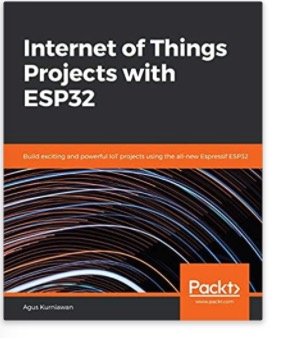 Internet of Things Projects with ESP32: Build exciting and powerful IoT projects
Internet of Things Projects with ESP32: Build exciting and powerful IoT projects
The ESP32, a low-cost MCU with integrated Wi-Fi and BLE capabilities, comes with a variety of modules and development boards for building IoT applications efficiently. Wi-Fi and BLE are standard network stacks for Internet-of-Things applications providing cost-effective solutions for your business and project requirements.
This book is a fundamental guide for developing ESP32 programs and starts by explaining GPIO (General Purpose I/O) programming with sensor devices. The reader gets up to speed with ESP32 development through several IoT projects such as weather stations, sensor loggers, smart homes, Wi-Fi cams, and Wi-Fi wardriving. The reader learns how to use ESP32 boards to facilitate interactions between mobile applications and cloud servers, such as AWS.
By the end of this book, you'll have learned how to control a range of IoT projects using the ESP32 chip.
 Loading... Please wait...
Loading... Please wait...

